What's new in 5.11 (2011-Dec-12 11:05):
*) hotspot - fixed https login (broken in v5.9);
*) eoip: swap tunnel id bytes to be compatible with previous versions;
*) eoip,gre: fix setting config
What's new in 5.10 (2011-Dec-09 11:49):
*) snmp - provide extended interface statistics when availabe;
*) dhcpv6 client - use link-scoped multicast address;
*) dhcp client - renew dhcp lease on ethernet link up event;
*) ipv6 gre tunnel added (/interface gre6) supports ip and ipv6 encapsulation;
*) ip gre tunnel supports ipv6 encapsulation;
*) allow setting bigger trafflow cache;
*) improved RB1200 stability when using ether9,ether10;
*) fixed RB1200 stability issues when using crypto hardware acceleration;
What's new in 5.9 (2011-Nov-29 14:32):
*) ssh - fix mempry leak when client uses public key authentication;
*) ppp - added support for new RADIUS attribute MT-Delegated-IPv6-Pool (#22);
*) ntp client - faster initial synchronization;
*) ppp - added support for dhcpv6 pd;
*) wireless - nv2 improvements for 11n cards;
*) hotspot - fixed login page to better handle big load;
*) wireless - change default rate-selection to advanced;
*) snmp - fix simple queue table;
*) webfig - fixed problem were users wihtout sensitive permission could download
senstive files (like backups);
*) webfig - fixed problem were table filters did not work allways as expected;
*) metarouter - fixed problem where local routeros instances did not boot;
*) dhcpv6 - client and server moved to respective /ipv6 dhcp- entry;
*) dhcpv6 server - changed how bindings are defined, users should add
missing static binding information after upgrade;
*) sms - send sms now uses channel from config if it's not specified in the command;
What's new in 5.8 (2011-Nov-01 10:14):ما الجديد في نسخة ميكروتك 5.11
*) snmp - fixed problem where some rows were missed
in a few tables when walking them;
*) ipv6 - added support for router address assignment from ipv6 pools;
*) routerboard - fix RB400/RB700 bootloader upgrade problem
*) radius - respond to CoA & Disconnect requests with the same ip address
it was received to;
*) improved webfig look;
*) webfig - do not allow to show secret passwords if user does not have
sensitive permission;
*) webfig - allow to customize all item names in skins;
*) updated timezone information;
*) lcd - added support for new ax93304 model and nexcom LCDs;
*) ppp - added support for ipv6 pools;
*) ppp - added support for Framed-IPv6-Pool radius attribute;
*) dhcp client - fix high CPU usage when interface is disabled;
*) snmp - trap interface filter, multiple trap targets;
*) dhcp - added server support for IPv6 prefix delegation from /ipv6 pool,
client support is also added;
*) ipsec - support authorization with raw RSA keys;
*) added ipv6 prefix pools;
*) winbox - now copied item in ordered list is added right after it's original;
*) pcq - fixed possible crash;
26 December 2011
تم اصدار النسخة الجديدة من ميكروتك 5.11
29 October 2011
الفرق بين RB750 و RB750G و RB750GL
Router Board 750
1-يحتوي على معالج 400MHz + 32MB RAM 2- MikroTik RouterOS v4, Level4 license
3- تقدر تعمل دمج من خطين ولحد اربع خطوط 4- الجهاز انتاج الشركه يعنى سوفتوير وهاردويراصلي
Router Board 750GL
http://routerboard.com/RB750GL
Router board 433AH
http://routerboard.com/RB433AH
Router Board 450G
http://routerboard.com/RB450G
Router board 493
http://routerboard.com/RB493
1-تلاته فتحات MiniPci لتركيب الكروت 2- RouterOS License Level 5
3- بروتوكولات التوجيهRIP2، OSPF. وBGP4 4- CPU speed 680Mhz + 256MB RAMRouter board 493G
http://routerboard.com/RB493G
تم اصدار النسخة الجديدة من ميكروتك 5.7
What's new in 5.7 (2011-Sep-14 10:54):
ما الجديد في نسخة ميكروتك 5.7
*) ovpn client - fixed crash when user name or password together
were longer than 11 symbols;
*) sstp client - added an option to skip
server address verification from certificate;
*) fixed problem - router crashed sometimes when using USB modem;
*) userman - show overall totals, show user totals if user has more
than one entry;
*) lcd - retrieving '/system lcd page' configuration did not work with
hundreds of interfaces;
*) webfig - added ability to reorder fields in skins;
*) webfig - added ability to add/remove new tabs & separators in skins;
*) webfig - added ability to add any field to special status page;
*) webfig - fixed problem when user sometimes got logged out with message
"internal server error";
*) webfig - logout didn't log user out from router;
*) webfig - added System/Password for changing user's own password;
*) system reset-configuration - if keep-users is specified ssh user keys are
preserved as well;
*) ipsec - new exchange mode (main-l2tp) for l2tp tunnel users to allow
FQDN as a peer ID with preshared key authorization in main mode;
*) ssh - fix possible server crash when connection is interrupted;
*) improved ipv4 forwarding performance on all boards with simple configuration
by up to 30%;
*) add passthrough setting to change-dscp, change-ttl, change-mss,
strip-ipv4-options, change-hop-limit mangle targets;
*) ipsec - fixed problem of RB1200 rebooting when large amount of UDP traffic is
sent through IPsec;
*) sniffer - added more useful packet filtering options, also available as quick
mode command parameters;
What's new in 5.6 (2011-Aug-02 14:45):
*) ipsec - fix a problem which could silently remove a manual policy
from the kernel if the peer configuration has 'generate-policy' set to 'yes'
and if the policy matches with the traffic selector of a SA being removed
on the responder side, also fix a problem that some generated policies
may stay in kernel after relevant SA was removed;
*) profiler - correctly show idle task on RB1200;
*) webfig - fix dual nstreme interface setting lists;
*) webfig - fix Wireless Access/Connect List editing;
*) webfig - fix bitrate presentation in simple queues (show 1.5M as 1500k);
*) fixed micro-sd access on RB400 not to stop everything else;
*) sstp - when server certificate verification is enabled for sstp client,
it will additionally compare IP addresses found in certificate's
subjectAltName and subject CN to the real address, DNS names are ignored;
*) tftp - optional block counter roll-over support;
*) hotspot - fixed possible crash in case of multiple Radius CoA requests;
*) userman - speedup user deletion with big log size,
note that first userman startup after this update
may take few minutes if the log size is in hundreds of MB;
*) mpls - added support for enabling/disabling control word usage for
BGP based VPLS tunnels (both - Cisco and RFC 4761 based);
*) mpls - added support for auto-discovery of VPLS NLRI encoding method
for Cisco BGP based VPLS tunnels;
*) winbox - sometimes after disconnecting, winbox could not connect back;
*) gre,ipip tunnels - new dscp parameter (0..63 or inherit);
*) ping - new dscp parameter;
What's new in 5.6:
*) bgp - allow parallel operation of RFC4761 "l2vpn" and
draft-ietf-l2vpn-signaling "l2vpn-cisco" BGP VPLS variants inside
single peering session.
*) console - ":resolve" command now returns IPv6 address for domain names
that have only IPv6 address records;
*) snmp - provide ups alarms for bad or low battery or for ups overload;
*) route - fixed SNMP getnext queries, were failing to find next
prefix in the OID order;
What's new in 5.5 (2011-Jun-20 14:43):
*) console - resolved problem that appeared in version 5.4. it caused
'sup-output' command to crash console on systems with many ethernet
interfaces or very long interface names.
*) serial console - do not automatically send login prompt to attached
usb modem if no other serial port exists;
*) winbox - fixed scrolling in terminal window;
*) webfig - encrypt whole session even in non https mode;
*) do not show contents of skin files to users without
'sensitive' permission;
What's new in 5.4 (2011-May-27 13:18):
*) webfig - do not try to open many windows
if first open was blocked by browser;
*) RB4xx ether1 port flapping fixed;
What's new in 5.3 (2011-Apr-29 15:05):
*) snmp - fix table get next with partial row keys;
*) snmp - respond from correct source address when multiple exist;
*) snmp - fix possible interface disappearing when walking ipNetToMediaTable;
*) snmp - fix possible memory leak;
*) ipsec - flush SAs and inform peer when rebooting or shutting down;
*) openvpn - fixed crash;
*) implemented terminal in WebFig;
*) implemented Skin mode in WebFig;
*) added support for more Broadcom Tigon3 based ethernet cards;
*) winbox - fixed byte to KiB, MiB and GiB conversion
(digit after decimal point could be a bit off);
*) console - align numbers right in tabular print output;
*) fixed RB450G, RB750G switch chip slow ethernet problem;
*) fix vlan disable not taking effect;
*) userman - fix Authorize.Net payment bypass;
*) userman - added profile option to overwrite shared users option
in user settings when profile is activated;
*) userman - fix db backup if it's size exceeds 2G;
*) wireless - merged ht-extension-channels in to channel-width;
What's new in 5.2 (2011-Apr-21 09:36):
*) fixed webfig;
*) console - fixed problem with supout file generation and export that
appeared in version 5.1, it was causing console to enter busy loop
on some boards;
*) ssh client - added source address and remote command options;
*) user manager - added /tool usermanager profile;
What's new in 5.1 (2011-Apr-08 12:55):
*) ipsec - fix SA lifetime display when timezone offset does not equal 0;
*) ipsec - now default DPD interval is 2 min for new configurations;
*) webfig - make bandwidth-test work;
*) fixed problem - wireless package got disabled after upgrading from v4;
*) sstp - fix problems on multicore systems;
10 April 2011
MPLS over PPPoE
Overview
This example shows how to set up MPLS network over PPPoE interfaces.Example network
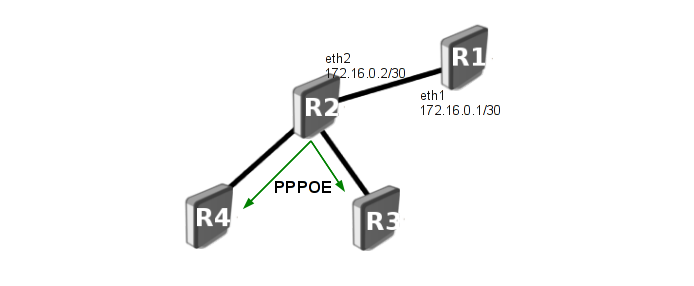
As you ca see from illustration above, router R2 is pppoe server and routers R3 and R4 are pppoe clients. Our goal is to run MPLS on this network.
When running MPLS over PPPoE or other tunnels you have to deal with MTU issues. Tunnels add more overhead (in our case PPPoE adds 8 more bytes). To be able to forward 1500 byte IP packet without fragmentation we will need interface that supports
- 1500 (IP frame)
- + 8 (PPPoE header)
- + 4 (MPLS header)
- = 1512bytes
Lets say that R2 is RB433 and pppoe clients are connected to ether2. From the table you can see that max supported l2MTU for this interface is 1522.
It means that router will be able to forward packets without fragmentations.
Note: Since v5.0 is added proper support for MPLS over PPP. Now by default MPLS is disabled, to enable it go to
/ppp profile menu and set use-mpls=yesConfiguration
R1
/system identity set name=R1 # add loopback interface /interface bridge add name=loopback /ip address add address=10.255.255.1/32 interface=loopback add address=172.16.0.1/30 interface=ether1 #set up ospf /routing ospf instance set default redistribute-connected=as-type-1 /routing ospf network add network=172.16.0.0/30 area=backbone # set up MPLS/LDP /mpls interface set 0 mpls-mtu=1512 /mpls ldp set enabled=yes lsr-id=10.255.255.1 transport-address=10.255.255.1 /mpls ldp interface add interface=ether1
R2
Note that we have to add static interface for each PPPoE clients, because later on these interfaces will be added to LDP configuration./system identity set name=R2 # add loopback interface /interface bridge add name=loopback /ip address add address=10.255.255.2/32 interface=loopback add address=172.16.0.2/30 interface=ether1 # set up pppoe /interface pppoe-server server add interface=ether2 service-name=mpls max-mru=1500 max-mtu=1500 /ppp secret add name=mplsR3 service=pppoe remote-address=192.168.0.2 local-address=192.168.0.1 add name=mplsR4 service=pppoe remote-address=192.168.0.3 local-address=192.168.0.1 /interface pppoe-server add name="mplsR3" user="mplsR3" service="mpls" add name="mplsR4" user="mplsR4" service="mpls" #set up ospf /routing ospf instance set default redistribute-connected=as-type-1 /routing ospf network add network=172.16.0.0/30 area=backbone add network=192.168.0.2/32 area=backbone add network=192.168.0.3/32 area=backbone # set up MPLS/LDP /mpls interface set 0 mpls-mtu=1512 /mpls ldp set enabled=yes lsr-id=10.255.255.2 transport-address=10.255.255.2 /mpls ldp interface add interface=ether1 add interface=mplsR3 add interface=mplsR4
R3
/system identity set name=R3 # add loopback interface /interface bridge add name=loopback /ip address add address=10.255.255.3/32 interface=loopback # set up pppoe /interface pppoe-client add name="mplsR3" max-mtu=1500max-mru=1500 interface=ether2 user="mplsR3" service-name=mpls #set up ospf /routing ospf instance set default redistribute-connected=as-type-1 /routing ospf network add network=192.168.0.1/32 area=backbone # set up MPLS/LDP /mpls interface set 0 mpls-mtu=1512 /mpls ldp set enabled=yes lsr-id=10.255.255.3 transport-address=10.255.255.3 /mpls ldp interface add interface=mplsR3
R4
/system identity set name=R4 # add loopback interface /interface bridge add name=loopback /ip address add address=10.255.255.4/32 interface=loopback # set up pppoe /interface pppoe-client add name="mplsR4" max-mtu=1500 max-mru=1500 interface=ether2 user="mplsR4" service-name=mpls #set up ospf /routing ospf instance set default redistribute-connected=as-type-1 /routing ospf network add network=192.168.0.1/32 area=backbone # set up MPLS/LDP /mpls interface set 0 mpls-mtu=1512 /mpls ldp set enabled=yes lsr-id=10.255.255.4 transport-address=10.255.255.4 /mpls ldp interface add interface=mplsR4
Testing
At first make sure pppoe clients are connected successfully[admin@R2] /ppp active> print Flags: R - radius # NAME SERVICE CALLER-ID ADDRESS UPTIME ENCODING 0 mplsR3 pppoe 00:0C:42:21:F1:EA 192.168.0.2 46m 1 mplsR4 pppoe 00:0C:42:21:F1:ED 192.168.0.3 46m55sCheck if OSPF is running properly
[admin@R2] /routing ospf neighbor> print 0 router-id=10.255.255.1 address=172.16.0.1 interface=wlan1 priority=1 dr-address=172.16.0.2 backup-dr-address=172.16.0.1 state="Full" state-changes=5 ls-retransmits=0 ls-requests=0 db-summaries=0 adjacency=5m19s 1 router-id=10.255.255.3 address=192.168.0.2 interface=mplsR3 priority=1 dr-address=0.0.0.0 backup-dr-address=0.0.0.0 state="Full" state-changes=4 ls-retransmits=0 ls-requests=0 db-summaries=0 adjacency=49m33s 2 router-id=10.255.255.4 address=192.168.0.3 interface=mplsR4 priority=1 dr-address=0.0.0.0 backup-dr-address=0.0.0.0 state="Full" state-changes=4 ls-retransmits=0 ls-requests=0 db-summaries=0 adjacency=50m31sEnsure LDP is running
[admin@R2] /mpls ldp neighbor> print Flags: X - disabled, D - dynamic, O - operational, T - sending-targeted-hello, V - vpls # TRANSPORT LOCAL-TRANSPORT PEER SEN 0 DO 10.255.255.3 10.255.255.2 10.255.255.3:0 no 1 DO 10.255.255.4 10.255.255.2 10.255.255.4:0 no 2 DO 10.255.255.1 10.255.255.2 10.255.255.1:0 no
[admin@R2] /mpls forwarding-table> print Flags: L - ldp, V - vpls, T - traffic-eng # IN-LABEL OUT-LABELS DESTINATION I NEXTHOP 0 expl-null 1 L 20 192.168.0.1/32 m 192.168.0.3 2 L 21 10.255.255.4/32 m 192.168.0.3 3 L 22 10.255.255.3/32 m 192.168.0.2 4 L 23 10.255.255.1/32 w 172.16.0.1 5 L 24 192.168.88.0/24 w 172.16.0.1Now we can check if packet switching is working as expected
[admin@R4] /mpls ldp neighbor> /tool traceroute 10.255.255.1 src-address=10.255.255.4
ADDRESS STATUS
1 192.168.0.1 13ms 19ms 143ms
mpls-label=23
2 10.255.255.1 38ms 15ms 14msVPLS over PPPoE
Overview
This example extends previous setup by connecting two local networks using VPLS tunnelExample network
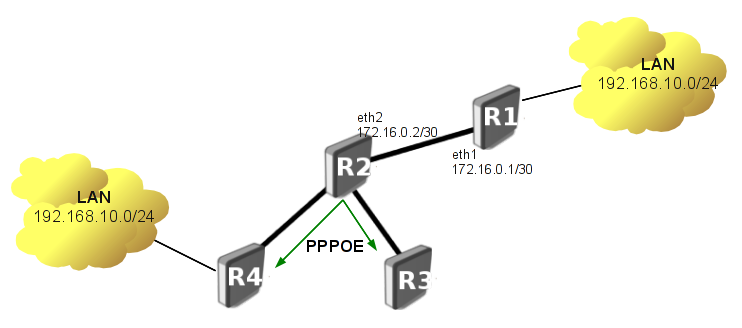
RouterBOOT changelog
What's new in 2.33:
- ) added support for Groove;
- ) added support for RB751G;
- ) fixed beep after failed flashfig on SXT 5HnD;
- ) Slight SXT booting speed improvement
- ) Flashfig initialization improvements (makes sound if Flashfig server not used)
- ) fixed RB1000 not to reset configuration all the time (broken in v2.29);
- ) fixed rare issue with large nand booting;
- ) fixed RB800 and RB1100 to turn on user led during boot-up;
- ) fixed RB711 to turn off user led during boot-up;
- ) fixed problem - wireless did not show up on some RB411 units with 18V PoE power supply;
- ) memory fix for RB800/RB1000/RB1100;
- ) fixed problem - sometimes wireless was missing on RB711 after reboot;
- ) fixed pin-hole reset on RB750G;
- ) added RB816 support on RB600;
- ) fixed router hangup during etherboot if blasted with lots of packets;
- ) added silent boot;
- ) fixed Flashfig;
- new feature - Flashfig;
- fixed etherboot on RB493;
- fixed occasional lockup of kernel image loading on RB400 series;
- added disable UART feature;
- added support for RB816;
- added support for RB750G;
- added support for RB800;
- fixed support for RB750;
- added support for RB750;
- added support for RB450G;
- fixed support for MLC NAND chip;
- fixed memory issue on RB600;
- fixed via-rhine disappearing on RB532 and RB564;
- added support for RB493AH;
- added support for MLC NAND chip;
- fixed bug - boot from NAND on RB532A could fail (bug introduced in 2.13);
- fixed bug - etherboot on RB433/RB450 at 10Mbit did not work;
- fixed RB333 overheating problem;
- added support for microSD card on RB433;
- fixed nand boot on RB150 (broken in v2.13);
- improved memtest;
- fixed RB600 memory issue;
- nand improvement for RB532A;
- fixed bug - in one rare case boot from NAND could fail with "data is corrupted" message while data is correctable in reality;
- 100ms delay before PCI bus are initialized;
- added support for RB192;
- fixed CompactFlash resetting router config on RB153 (broken in v2.7);
- fixed bug - RouterOS command "/system reset-configuration"
- added support for RB532r5;
- fixed CompactFlash reseting router config on RB153;
- fixed etherboot on RB100 to work reliably;
- fixed repeated initrd image loading;
- fixed crash during memory test within RouterBOOT;
- added support for RB153;
- fixed nand format feature to mark back really bad blocks as bad;
- reset-jumper resets bios settings to defaults;
- fixed reboot failure on RB500 with new RAM modules;
- added workaround for reboot failure on RB500 with new RAM modules;
- new boot option - "boot NAND, if fail then Ethernet";
- fixed bug - it was possible for RB500 booter to stop working completely;
- added nand format feature;
- added support for large block NAND devices;
- fixed bios entering on
key for hyperterminal; - routerboard 100 beep before jumping to kernel code;
- added nand READY/BUSY checking for rb100;
- improved speed for memory test;
Netinstall
NetInstall Description
NetInstall is a program that runs on Windows computer that allows you to install MikroTiK RouterOS onto a PC or onto a RouterBoard via an Ethernet network.NetInstall is also used to re-install RouterOS in cases where the the previous install failed, became damaged or access passwords were lost.
- Your device must support booting from ethernet, and there must be a direct ethernet link from the Netinstall computer to the target device. All RouterBOARDs support PXE network booting, it must be either enabled inside RouterOS "routerboard" menu if RouterOS is operable, or in the bootloader settings. For this you will need a serial cable.
- Netinstall can also directly install RouterOS on a disk (USB/CF/IDE) that is connected to the Netinstall Windows machine. After installation just move the disk to the Router machine and boot from it.
Screenshot
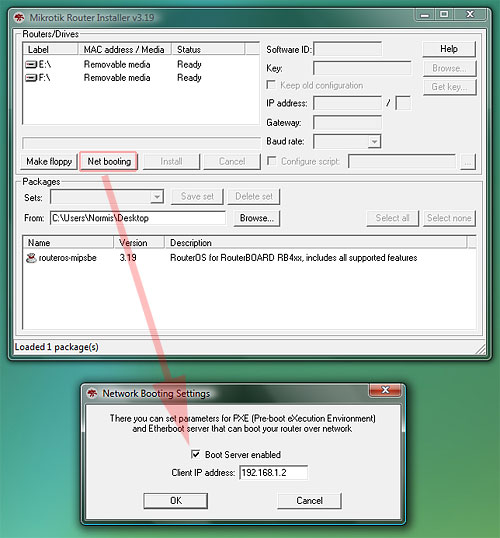
- for installation over network, don't forget to enable the PXE server, and make sure Netinstall is not blocked by your firewall or antivirus. The connection should be directly from your Windows PC to the Router PC (or RouterBOARD), or at least through a switch/hub.
NetInstall Example
This is a step by step example of how to install RouterOS on a RouterBoard 532 from a typical notebook computer.Requirements
The Notebook computer must be equiped with the following ports and contain the following files:- Ethernet port.
- Serial port.
- Serial communications program (such as Hyper Terminal)
- The .npk RouterOS file(s) (not .zip file) of the RouterOS version that you wish to install onto the Routerboard.
- The NetInstall program available from the Downloads page at www.mikrotik.com
Connection process
- Connect the routerboard to a switch, a hub or directly to the Notebook computer via Ethernet. The notebook computer Ethernet port will need to be configured with a usable IP address and subnet. For example: 10.1.1.10/24
- Connect the routerboard to the notebook computer via serial, and establish a serial communication session with the RouterBoard. Serial configuration example in in the Serial console manual
- Run the NetInstall program on your notebook computer.
- Press the NetInstall "Net Booting" button, enable the Boot Server, and enter a valid, usable IP address (within the same subnet of the IP address of the Notebook) that the NetInstall program will assign to the RouterBoard to enable communication with the Notebook computer. For example: 10.1.1.5/24
- Set the RouterBoard BIOS to boot from the Ethernet interface.
Configuring Bootloader
To access Routerboard BIOS configuration: reboot the Routerboard while observing the activity on the Serial Console. You will see the following prompt on the Serial Console “Press any key within 2 seconds to enter setup” indicating that you have a 1 or 2 second window of time when pressing any key will give you access to Routerboard BIOS configuration options.(press any key when prompted):
You will see the following list of available BIOS Configuration commands. To set up the boot device, press the 'o' key:
What do you want to configure? d - boot delay k - boot key s - serial console l - debug level o - boot device b - beep on boot v - vga to serial t - ata translation p - memory settings m - memory test u - cpu mode f - pci back-off r - reset configuration g - bios upgrade through serial port c - bios license information x - exit setup
Next Selection: Press the 'e' key to make the RouterBoard to boot from Ethernet interface:
Select boot device: * i - IDE e - Etherboot 1 - Etherboot (timeout 15s), IDE 2 - Etherboot (timeout 1m), IDE 3 - Etherboot (timeout 5m), IDE 4 - Etherboot (timeout 30m), IDE 5 - IDE, try Etherboot first on next boot (15s) 6 - IDE, try Etherboot first on next boot (1m) 7 - IDE, try Etherboot first on next boot (5m) 8 - IDE, try Etherboot first on next boot (30m)
The RouterBoard BIOS will return to the first menu. Press the 'x' key to exit from BIOS. The router will reboot.
Installation
Watch the serial console as the RouterBoard reboots, it will indicate that the RouterBoard is attempting to boot to the NetInstall program. The NetInstall program will give the RouterBoard the IP address you entered at Step 4 (above), and the RouterBoard will be ready for software installation. Now you should see the MAC Address of the RouterBoard appear in the Routers/Drives list of the NetInstall program.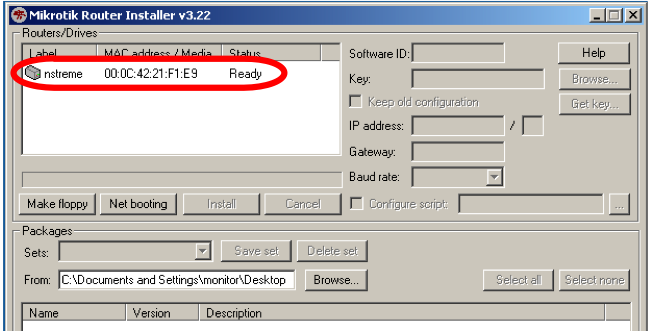
Click on the desired Router/Drive entry and you will be able to configure various installation parameters associated with that Router/Drive entry.
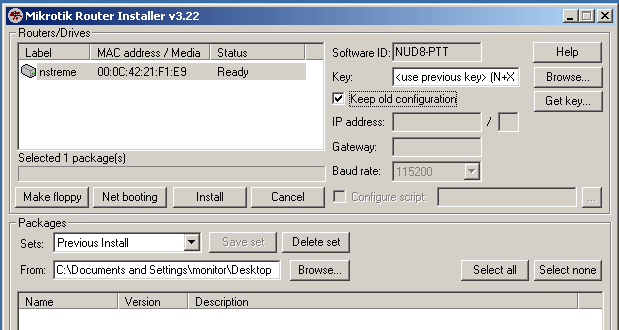
For most Re-Installations of RouterOS on RouterBoards you will only need to set the following parameter:
Press the "Browse" button on the NetInstall program screen. Browse to the folder containing the .npk RouterOS file(s) of the RouterOS version that you wish to install onto the Routerboard.
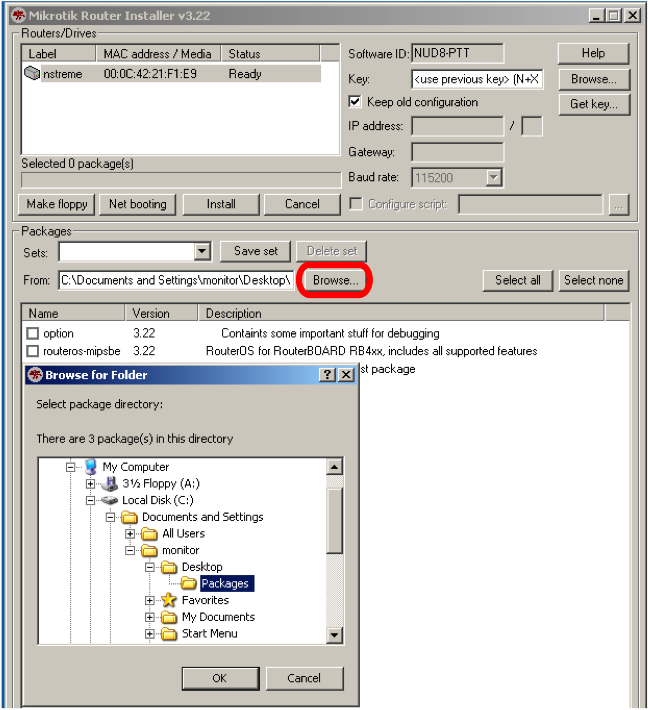
When you have finalized the installation parameters, press the "Install" button to install RouterOS.
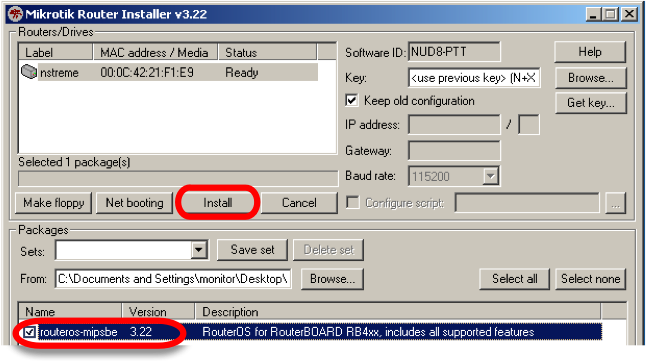
When the installation process has finished, press 'Enter' on the console or 'Reboot' button in the NetInstall program.
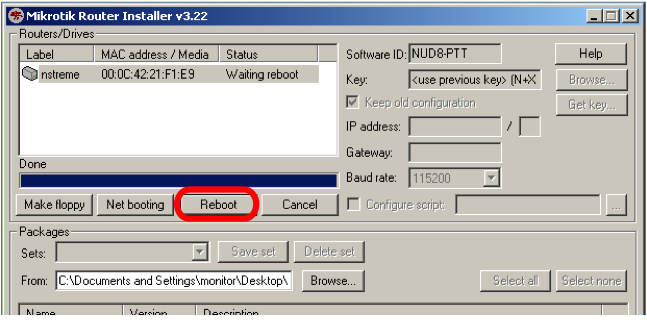
Cleanup
1. Reset the BIOS Configuration of the RouterBoard to boot from its own memory.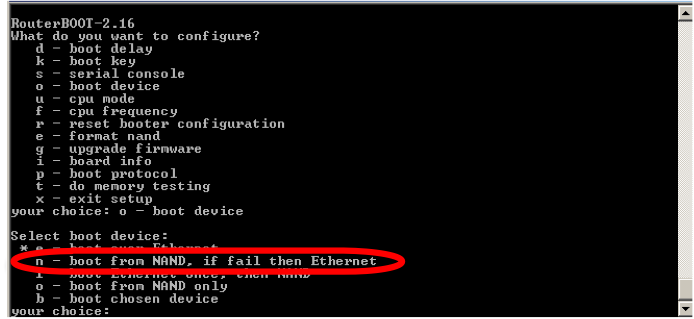
2. Reboot the RouterBoard.
Reset RouterOS Password
Netinstall can be used to reset password of RouterOS by erasing all configuration from the router. Uncheck 'Keep Old Configuration' during Netinstall and proceed with standard procedure,04 April 2011
MikroTik RouterBoard Bootloader upgrade تحديث البوت لودر في بوردة الميكروتك "روتربورد"
This page shows how to upgrade the Bootloader firmware of a RouterBOARD device.
First, check your RouterOS version - does it have the routerboard package installed?
In this case you see, that there is a newer version of the Bootloader firmware available already inside your current RouterOS version. Note! New Bootloader versions come with the routerboard.npk package when you install and upgrade your router, this is why always make sure you have not forgotten to install this package.
Do the upgrade command now:
Routerboot will be upgraded.
First, check your RouterOS version - does it have the routerboard package installed?
[admin@MikroTik] > system package print Flags: X - disabled # NAME VERSION SCHEDULED 0 system 4.0 1 routing 4.0 2 hotspot 4.0 3 advanced-tools 4.0 4 mpls 4.0 5 security 4.0 6 X ipv6 4.0 7 ppp 4.0 8 dhcp 4.0 9 routeros-mipsbe 4.0 10 routerboard 4.0 11 wireless 4.0 [admin@MikroTik] >Then, check your RouterBOARD Bootloader version:
[admin@MikroTik] > system routerboard print
routerboard: yes
model: "750"
serial-number: "1FC201DD513B"
current-firmware: "2.18"
upgrade-firmware: "2.20"
[admin@MikroTik] > In this case you see, that there is a newer version of the Bootloader firmware available already inside your current RouterOS version. Note! New Bootloader versions come with the routerboard.npk package when you install and upgrade your router, this is why always make sure you have not forgotten to install this package.
Do the upgrade command now:
[admin@MikroTik] > system routerboard upgrade
Routerboot will be upgraded.
Second method
If for some reason routerboard.npk package is not, and can not be installed for your RouterOS version, you can upload the Bootloader file directly to the Files folder in RouterOS, and do the command then.Third method
If there is no IP connectivity with your RouterBOARD, you can also use the Serial Console XMODEM transfer to send the FWF file to the router, while connected via Serial Console. From the Bootloader menu it's possible to upgrade the firmware with this method. This method is the last resort, and should be used only if the first two methods are not available.03 April 2011
Mikrotik RouterOS v 5.0 Released تم اصدار النسخة 5 من ميكروتك
What's new in 5.0 (2011-Mar-31 11:33):
ما الجديد في الاصدار 5 من ميكروتك
*) route - fixed cause of crashes when handling multipath routes;
*) route - fixed limit on maximum active IPv6 route count,
was causing issues with more than 2000 active routes;
*) ipsec - added command kill-connections under remote-peers;
*) ipsec - fix responder side phase2 negotiation problem
which prevented more than one Windows7 host to initiate SA;
*) fixed vrrp - interface was invalid after undoing remove;
*) winbox - added more detailed /interface ethernet stats;
*) winbox - added ability to send e-mail;
*) winbox - added missing 'set-metric' parameter
in 'Routing/Prefix List';
*) wireless - 802.11 dynamic distance fix;
*) fixed problem - packages could not be uninstalled if disk was full;
*) fixed problem - some of the RouterBOARDS did not reboot properly sometimes;
*) fixed problem - VLANs on bridge interface did not work;
*) ssh - client supports public key authentication;
What's new in 5.0rc11 (2011-Mar-04 14:29):
*) led trigger - changed blinking for modem signal and interface monitoring;
*) ppp - added ability to specify data-channel for ppp server interfaces;
*) ipsec - added more Diffie-Hellman groups;
*) console - fixed a memory leak;
*) console - don't recreate default '/system console' entry for the serial
port if it is removed;
*) netinstall - fixed CD-ROM & usb install;
*) wireless nv2 - fixed RB532 freeze;
*) wireless - fixed station-bridge mode;
*) wireless - added station-bridge support for 802.11 and nstreme;
*) gps - show higher precision coordinates;
*) snmp - added OIDs for kvm and metarouter;
*) usermanager - works again and to make user profile active after signup,
please recreate relevant user profiles;
What's new in 5.0rc10 (2011-Feb-17 14:06):
*) routing - fixed ipv6 connected routes,
IPv6 connected routes disappeared after interface restart;
*) routing - fixed high CPU usage when adding BGP ipv6 routes;
*) winbox - fixed opening terminal window to KVM instance;
*) winbox - fixed connect button in wireless scan;
*) winbox - fixed make-binding in hotspot hosts;
*) ipsec - fix possible crash when ipv6 is enabled;
*) snmp - add usb power reset (see updated MIB);
What's new in 5.0rc9 (2011-Feb-09 13:57):
*) wireless - fixed disconnect problem on long distance
802.11 40MHz links;
*) wireless nv2 - fixed station mode that broke when station-bridge
was introduced
*) wireless - more improvements for 11n compatibility;
*) routing - fixed problem with best route selection, sometimes inferior route
could get selected as the active, problem was introduced in 5.0rc8;
*) kvm - fix guest starting;
What's new in 5.0rc8 (2011-Feb-01 14:03):
*) added led trigger - change leds on different events;
*) snmp - restored access to routing tables;
*) snmp - fixed memory leak for OID 1.3.6.1.2.1.25.2;
*) ipsec - added ipv6 support;
*) removed broadcast setting from ip address;
*) radv - fixed problem when wrong link local address was used
to send advertisements on bridge interface;
*) ppp - make IPv6 work again (introduced in v5.0rc7);
*) ppp - fixed problem when user re-authenticated and traffic accounting
included data from previous session;
*) fixed traffic-flow on x86-smp (could stop sending flows);
*) improved usb modem mode switching;
*) kvm - fixed problem when sometimes virtualization detection fails;
*) routing - route with recursive gateway sometimes was not selected as
active, if another inferior route with directly reachable gateway
was present;
*) bgp - removed "interface" property from bgp peer configuration, now
ipv6 link local remote address must be specified using the
"address%interface" notation;
*) added extended ethernet statistics (/interface ethernet print stats) for RB800,RB1000,RB1100 and RB7xx with AR7241 or newer cpu;
*) wireless - improved 11n compatibility;
*) wireless nv2 - added support for station-bridge mode;
*) wireless nv2 - added area support;
*) wireless - added ability to set registration-table comment using RADIUS
attribute;
*) implemented usb power-reset command on RB SXT 5HnD;
What's new in 5.0rc7 (2010-Dec-29 10:39):
*) fixed hotspot;
*) tftp - fixed problem when nobody could
connect if no ip-address were provided;
*) winbox - fixed mac ping from neighbor list;
*) fixed simple queues on little endian cpus;
*) fixed simple queues without provided dst-address;
*) fixed problem - could not update license for
old style 7 digit software-id's;
*) fixed winbox - IPv6 route could not be added;
*) ssh - allow bigger packets (fixes some disconnecting problems);
*) added support for RDC R6040 Ethernet controller;
What's new in 5.0rc6 (2010-Dec-23 13:33):
*) ntp server now requires a broadcast address for broadcast mode to work
it should be specified under broadcast-addresses (X.X.X.255),
255.255.255.255 is not going to work;
*) ssh - fixed showing forwarding settings,
check your setting after upgrade!
*) allow to specify multiple networks (including IPv6)
in user's allowed-from list;
*) added support for Safe Mode to WinBox;
*) allow to specify non acceptable groups for RADIUS console logins;
*) handle correctly IPv6 address on bridged or switched interfaces;
*) added IPv6 connection list;
*) added IPV6 support to graphing;
*) added IPv6 support to SNTP client;
*) added IPv6 support to NTP client & server;
*) added IPv6 support to RADIUS client;
*) added IPv6 support to snmp;
*) added IPv6 support to tftp server, also changed logging levels;
*) added IPv6 support to ssh client;
*) added IPv6 support to watchdog;
*) added IPv6 support for /tool e-mail;
*) added IPv6 support to log remote target;
*) added IPv6 support to API;
*) added IPv6 support to winbox;
*) added IPv6 support to ftpd;
*) added IPv6 support to netwatch;
*) added IPv6 support for /queue simple;
*) added IPv6 support for /tool bandwidth-test;
*) added IPv6 support for /tool torch;
*) added IPv6 support for /interface vrrp (version 3);
*) added IP/IPv6 over ipv6 tunnel interface (/interface ipipv6);
*) added Ethernet over IPv6 tunnel interface (/interface eoipv6);
*) snmp - added ipv6AddrTable from IPV6-MIB;
*) wireless nv2 - fixed station-wds mode multicast problem;
*) wireless nv2 - fixed occasional encrypted link stalls;
What's new in 5.0rc5 (2010-Dec-01 07:47):
*) logging - added email-starttls option for email target;
*) pcq - added burst settings, like in "/queue tree" and "/queue simple";
*) pcq - can specify address masks for pcq;
*) pcq - added ipv6 support;
*) wireless - fixed WPA;
*) radius - fixed encryption key decoding for wireless EAP & PPPs;
*) winbox - make keyboard work right away after main window is activated;
*) snmp - fix BER encoding for negative INTEGER values;
What's new in 5.0rc4 (2010-Nov-22 16:58):
*) radius - fixed Disconnect and CoA response signature generation;
*) winbox - make double click work in text fields again;
*) winbox - allow to drag windows outside of main one to the left;
*) winbox - make some settings look more consistent;
*) winbox - allot to specify IPv6 address in routing filter prefix;
*) winbox - make possible to open IPv6 routes without crashing;
*) winbox - improved item reordering in long lists;
*) winbox - improved SNMP configuration support;
*) winbox - added support for KVM configuration;
*) winbox - added support for Traffic Engineering configuration;
*) ovpn - make ovpn client work with OpenVPN v2.1.3;
*) lcd - support Crystalfontz 631,633
also support for Crystalfontz lcd contrast setting is added;
*) console - fixed missing return value of the ping command when executed
from a scheduler entry;
*) console - 'ping' command with specified value of 'interface' always forced
"arp-ping=yes", fixed;
*) routing - fixed problem with 'check-gateway' status update that could get
triggered when multiple routes with different values of 'target-scope'
and 'check-gateway' referenced the same gateway IP address;
*) store - allow to use external disks;
*) modem firmware directory can be specified in /port firmware
Gobi users should change this setting or directory name;
*) ups - support USB UPS on RB4xx as well;
*) snmp - fix BER encoding for some INTEGER based values;
*) snmp - provide proxy stats using SQUID-MIB;
*) snmp - provide ups info using UPS-MIB;
*) snmp - provide external storage information;
*) wireless nv2 - add missing statistics fields;
*) wireless - add per-chain signal strength fields;
*) added hotspot html variable "host-ip";
*) fixed pcq queue type;
*) fixed leds on RB750;
*) added hotspot html variable "host-ip";
*) wireless nv2 - fixed station-wds mode multicast problem;
*) wireless nv2 - fixed occasional encrypted link stalls;
What's new in 5.0rc3 (2010-Oct-29 09:02):
*) lcd - support Crystalfontz 635
*) wireless nv2 - fix stalls on encrypted 11n links using high rates;
*) wireless nv2 - fix encryption related kernel crash;
*) sstp - fixed memory leak;
*) fixed problem - bad boot/kernel crc was reported on powerpc boards
when in fact it was good;
What's new in 5.0rc2 (2010-Oct-27 16:20):
*) wireless nv2 - encryption support;
*) tool fetch - support ftp STOR;
*) ospf - fixed crash when working with external LSA that contain
forwarding addess;
*) ipsec - supports NAT-T drafts;
*) ipsec - added debug logging, to maintain same log verbosity as before with
'ipsec' topic now use topics 'ipsec,debug,!packet';
*) ipsec - make it work with EoIP, GRE, PPTP and L2TP;
*) support for Atheros AR9271 wireless chip;
*) added support for more Intel 82575/82576 PCI-Express Gigabit Ethernet cards;
*) added support for idle detection on RB1xx/RB5xx in /tool profile;
*) fixed Wireless manual tx power configuration for 11n rates in WinBox;
*) fixed torch;
What's new in 5.0rc1 (2010-Sep-17 13:58):
*) wireless nv2 - add WDS support;
*) added ability to monitor cpu usage by task (/tool profile);
*) added support for RPS (Receive Packet Steering) on multicore systems;
*) added cisco compatible gre tunnels;
*) fix simple queues on multicore (fixes intel 82576 crash/reboot);
*) fixed sstp memory leak;
*) winbox - fixed ability to configure RB1100 switches;
*) ssh - fix possible crashing;
*) snmp - fix GET request processing;
*) ipsec - added ability to specify ID_USER_FQDN peer identity;
*) ipsec - encypt last IKE phase 1 packet when in aggresive mode as initiator;
*) wireless nv2 - added nv2-cell-radius parameter to specify distance
in km to farthest client on AP;
*) wireless nv2 - fix transmit stall issue for non-11n chips;
*) wireless - fix x86 nstreme multiprocessor hang;
*) made user manager web interface work again;
*) updated drivers and kernel (to linux-2.6.35);
What's new in 5.0beta6 (2010-Aug-10 13:22):
*) sstp - fixed memory leak;
*) wireless - changed band setting and added channel-width setting
*) wireless - support for 11n rates in 5&10mhz channels
*) wireless nv2 - fixed multiple problems including occasional tx stall;
*) made gps accessible through SNMP;
*) snmp - added GETBULK support, no more table caching - solves problems
with huge tables, routing tables currently are not available;
*) ssh - fixed public key authentication in case
when client is not verifying if server will accept the key;
*) fixed problem - MetaROUTER did not work on RB800, RB1000 & RB1100;
*) user manager is not working - will be fixed in next version;
*) intel 82576 (uncommon expensive chip) crash/reboot to be fixed in
next release;
What's new in 5.0beta5 (2010-Jul-23 14:50):
*) email - supports multiple CCs
*) fix 5&10MHz channel support for 11n cards;
*) ssh - fix ssh client crash;
*) ssh - password authentication is disabled for users with public keys;
*) ping - fixed ping packet-loss calculation;
What's new in 5.0beta4 (2010-Jun-28 16:17):
*) console - /ping command again returns number of ping responses received,
didn't work in 5.0beta3;
*) added ability to monitor each cpu core usage;
*) added support for SATA,SCSI & USB CD-ROMs in CD installer;
*) fixed problem - IRQ balancer did not use correct CPU core
on non auto MSI irqs after reboot;
*) fixed memory leak;
*) route - new property 'vrf-interface' (for static and dhcp routes),
automatically updates 'routing-mark' of the route to keep it in the same
VRF as the specified interface;
What's new in 5.0beta3 (2010-Jun-17 13:46):
*) hotspot - drop hotspot specific tcp connections from non-hotspot clients
already at firewall;
*) lcd - added support for AX89063
*) console - output of '/ping' and '/tool traceroute' commands is more
in line with the rest of the console commands;
*) api - '/ping' and '/tool traceroute' commands are fully functional;
*) console - added 'server' and 'server-port' arguments to '/resolve' command;
*) lcd - show free/total memory in units of million bytes (MB);
*) lcd - added page that shows system identity;
*) sstp - made it work with Windows 7;
*) sstp server - client reconnects did not work;
*) winbox - implemented proper maximize support for inner windows;
*) fix 5&10MHz channel support for 11n cards;
*) added IRQ balancer;
*) enabled PCI MSI on i386 multicore setups;
What's new in 5.0beta2 (2010-Apr-30 11:24):
*) added wireless distance setting, removed ack-timeout;
*) improved 802.11 operation for outdoor distances;
*) fixed sstp on x86;
*) console - removed 'delay' argument from '/system scheduler add' command;
*) console - remove 'comment=""' values from export;
*) console - updated '/system script job':
- also show active login sessions here;
- new read-only property 'type' with values "command", "login"
or "api-login" for running commands and either kind of login sessions;
- new optional read-only property 'parent' with id of the job that
has spawned this one;
*) console - changed "started" property of '/system script job' to use
local time;
*) console - new property 'type' in '/system script job'
*) console - added '/port remote-access export' command;
*) console - fixed bug that caused "cannot set ..." error when using
some properties in 'find' commands;
*) show old software id in export file header;
*) api - can supply password to '/system/upgrade/upgrade-package-source/add';
*) api - 'print' command was not showing values of some properties
such as 'servers' in "/ip/dns";
*) api - fixed api login sessions not dissapearing from '/user active' after
termination;
*) '/user active' now lists type of api connections as 'api';
*) added support for hardware watchdog on RB1000 & RB800;
*) added support for ASIX AX88xxx based USB Ethernet Adapters on RB4xx;
*) fixed problem - ipv6 traffic was not bridged if ipv6 package was not enabled;
*) fixed getting interface stats in dude;
*) fixed metarouter stability problem on RB400s & RB750s;
*) fixed metarouter - it didn't work on RB1000 with 2Gb;
*) fixed metarouter - it locked up on RB800;
*) fixed problem - SFQ queues did not work on interfaces (wireless) if none
of simple or tree queues were added;
*) fixed RB800 temperature;
*) fixed problem - WinBox crashed while opening VAP interface;
*) dhcp server - fixed possible inactive dhcp server in case of many
dhcp leases with address-pool enabled;
*) dhcp server - show non-printable option 82 agent-circuit-id and
agent-remote-id values in hexadecimal notation
(in the same way as client-id is shown);
What's new in 5.0beta1 (2010-Mar-31 09:17):
*) updated drivers and kernel (to linux-2.6.32.5);
*) ssh is now completely rewritten (supports connection forwarding, only DSA keys);
*) added support for SSTP protocol (PPP over TLS);
*) added support for multiple Intel Ethernet cards;
*) added support for IPv6 over PPP
(enabled by default if ipv6 package is installed),
link-local addresses are assigned, and server can issue IPv6 global prefixes
to clients per ppp secret or RADIUS reply (Framed-IPv6-Prefix);
*) added proper support for MPLS over PPP (by default it is now disabled);
*) fixed RB800 temperature;
*) silentboot feature updated;
*) WinBox - any file dropped on WinBox will be uploaded to router;
*) multicast - fixed possible crash during PIM startup;
*) report platform name in "/sysrem resource";
*) fixed problem - vlans were not working on RB750 ether1;
*) fixed mac address handling on RB750, some specific arp requests did not work;
*) more than two dns servers allowed in /ip dns;
*) sniffer and torch could process packet from other interfaces;
*) ospf - fixed DR and BDR election;
*) ospf - changed "/routing ospf route" to show type 2 metric instead of
internal metric for type 2 external routes;
*) added IPv6 support to trafflow (v9 only);
*) rewritten user-manager (formerly known as userman-test);
*) dns cache rotates order of records in reply messages
What's new in 4.6:
*) only accept dotted decimal notation for IP addresses. Use of numbers
with leading zero, numbers larger than 255 and non-decimal numbers
is not accepted (but still can omit third or second and third numbers,
if they are zero);
*) email - user must enable tls explicitly
*) remove limit on number of multicast enabled interfaces, maximum was 32;
*) dhcp server - show last-seen time for leases;
*) fixed - when closing winbox terminal window with active serial-terminal
console command, serial port sometimes was left in acquired state;
What's new in 4.5:
*) ipsec - added blowfish, twofish, and camellia encryption algorithms;
*) fixed static route removing;
*) fixed DHCP client compatibility with some DHCP servers;
*) added static multi-cast route support;
*) fixed temperature monitor on RB800 and RB450G;
*) user manager - payment bug fix - now able to buy
credits without extend price specified;
What's new in 4.4:
*) snmp - fixed snmp version three;
*) snmp - fixed vlan interface speed;
*) hotspot - fixed radius variables in hotspot html pages;
*) removed support for xen;
*) routing - added support for BFD protocol;
*) fixed problem - MetaROUTER sometimes froze on RB4xx;
*) fixed OSPFv3 on bridge interfaces;
What's new in 4.3:
*) kvm - vnc support, booting from cdrom image
*) API - fixed possible crash when running concurrent commands;
*) console - fixed logging commands: 'warning', 'error' and 'debug' were
all using 'info' topic;
*) bgp - added routing-table configuration option for instances;
*) bgp - added 'as-override' and 'passive' configuration options for peers;
*) bgp - added support for Site of Origin extended communities;
*) bgp - fixed some network issues;
*) ospf - fixed problem: when last neighbor on multi-access interface disappeared,
incorrect RouterLSA was generated on designated router;
*) metarouter - allow to specify metarouter's memory size when importing image;
*) firewall - added 'routing-table' matcher;
*) fixed problem - e1000 driver did not work in virtual machines;
What's new in 4.2:
*) fixed problem - RB450G ethernet did not work if one of the ports was disabled;
*) fixed ethernet of RB433 with switch chip IP175D;
*) fixed route attribute problem;
*) fixed route next-hops falling under multiple connected routes;
What's new in 4.1:
*) fixed problem - RB750 (clocked at 300MHz) Ethernet did not work;
*) fixed problem - routes on some interfaces (like VLAN) were not activated;
*) ppp, gps, sms, serial terminal - allow use of different channels
on same port across multiple programs simultaneous
*) dhcp server - added support for dynamic address-list entries;
*) hotspot - added support for dynamic address-list entries;
*) hotspot - fixed redirect after login in case if client gets new IP address
(problem introduced in 3.28);
What's new in 4.0:
*) IT87XX hardware monitoring sensor support;
*) kvm allows to choose emulated nic model;
*) hotspot - fixed redirect after login in case if client gets new IP address
(problem introduced in 3.28);
*) hotspot - fixed redirect after login in case if client gets new IP address;
*) console - commands like 'monitor', 'torch' and others that periodically
refresh information sometimes failed to work when started from
the scheduler;
*) console - scheduled scripts no longer require 'test' policy to run;
*) console - fix issues with scripts that contain lines with trailing spaces;
*) console - add back compatibility with old scripts that use space instead
of '=' to separate argument name and value;
*) console - following fixes:
- accept item numbers when prompted by command to specify item;
- argument names without '=' were matched even when expecting unnamed
value; this broke code such as:
:foreach i in=1,2,3 do {}
here 'i' was matched as argument name "in";
- 'tab' key did not automatically append '=' after complete argument
names;
What's new in 4.0rc1:
*) console - removed support for Lua (will be reintroduced later);
*) incorporated all the bug fixes since v3.30;
*) port remote-access - added 'log-file' property. If value is a non-empty
string, then all data that is read from the port is appended to a file
with that name, regardless of the active remote connection;
*) console - removed '/user' from the output of top level '/export' command,
still can be exported by '/user export';
What's new in 4.0beta4:
*) routing - changed BGP network and default-originate behavior;
*) web proxy - allow to edit error page;
*) console - terminal window size change now does not trigger full terminal
reset;
*) mesh protocol - improved loop prevention (becomes incompatible with earlier versions);
*) incorporated all the bug fixes since v3.27;
What's new in 4.0beta3:
*) added support for 802.11n atheros based wireless cards;
*) added ability to run other OSs in MetaROUTERs;
*) console: Lua scripting language. http://wiki.mikrotik.com/wiki/Lua
*) console: added nstreme-dual OIDs;
*) incorporated all the bug fixes since v3.23;
What's new in 4.0beta2:
*) console: added 'without-paging' argument to 'monitor' commands;
*) console: now 'without-paging' and 'interval' arguments in of 'print'
commands work together. Printing can be stopped by pressing 'q' or
ctrl-c, any other key triggers printing;
*) incorporated all the bug fixes since v3.22;
*) fixed TFTP server logging;
*) fixed problem - "/system upgrade" did not show proper package
architecture and was unable to fetch new packages;
What's new in 4.0beta1:
*) added support for MetaROUTERs;
*) all test packages are regular ones;
*) console - can mix named and unnamed arguments, can use names for unnamed
argument values. For example all of the following commands are
accepted now:
/ping 10.11.12.13 count=4
/ping address=10.11.12.13 count=4
/ping count=4 10.11.12.13
GoDaddy coupon code , offers & promotions
Subscribe to:
Posts (Atom)